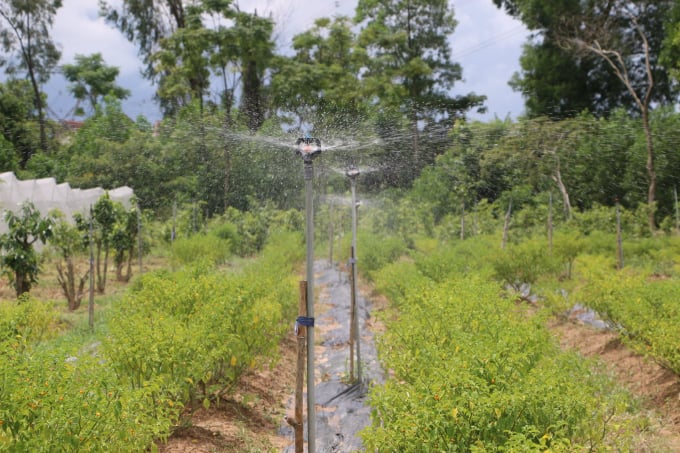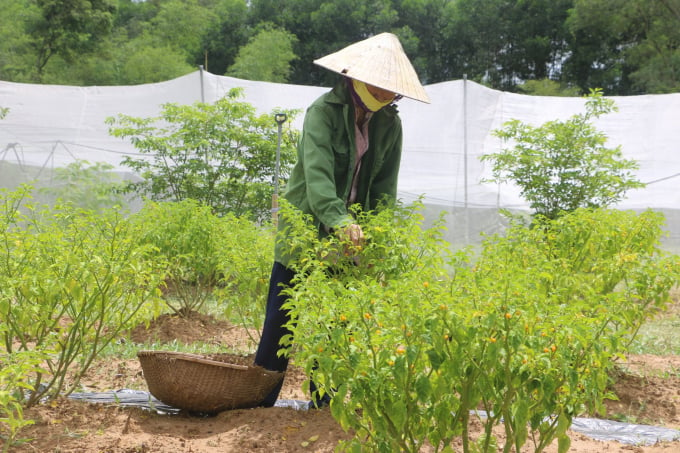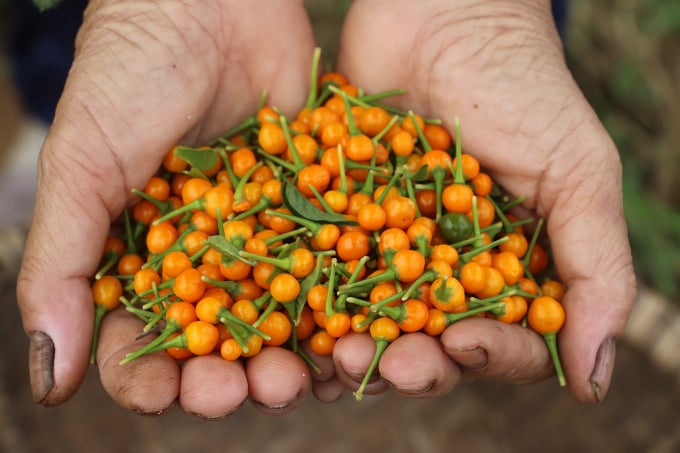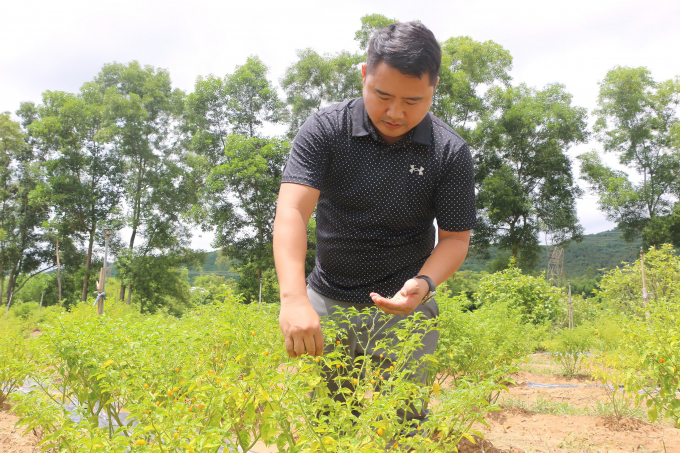November 23, 2025 | 13:39 GMT +7
November 23, 2025 | 13:39 GMT +7
Hotline: 0913.378.918
November 23, 2025 | 13:39 GMT +7
Hotline: 0913.378.918

Tan and the team's chili growing model is entirely using organic methods.
At the beginning of 2020, after a period of immersing into studies and research, Le Sy Tan (born 1982) in Thien Loc commune, Can Loc district along with Truong Van Thuy (born 1968) and some close friends invested VND 200 million in Peruvian chili seeds for import and trial planting at Thuy's 1 ha farm in Quy Linh village, Thach Xuan commune, Thach Ha district.
In the early stages of production, since he did not understand the growth characteristics of this chili, Tan failed to germinate the seeds. Learning from experience, in the second phase, he switched to importing 200 seedlings with an amount of nearly VND 50 million to plant. However, this time more than half of the plant slowly withered after a period of sowing.
Undeterred by failures, Tan and his teammates searched for documents, went on the internet to carry out a thorough study of the plant’s characteristics, find the cause of the two failed planting, and then search for solutions that could overcome the situation. As a result, in the third trial planting, Tan's model had developed 500 chilis, and they are currently in the harvesting period.

500 chili plants create a profit of approximately VND 300 million per year.
“Peruvian yellow chili peppers grow and develop best at a temperature of 25 to 37 oC. After planting for about 4 months, the plant can bear fruit. This chili is small in size, so it takes a long time to harvest. Another thing is that this type of chili has the characteristic that it will lose its taste if harvested immediately after the rain, so we can only make use of the sunny days to pick it to ensure the best quality," said Tan.
And according to the model’s boss, his 500 chili plants are grown entirely by organic methods. From seed to fertilizer and irrigation water must be clean so that the new chili peppers hold the highest nutrition content.

The output market for this variety described as the “world’s most expensive chili” has its door wide open.
Peruvian yellow chili peppers can harvest for 5-6 crops. If well cared for, the plant can produce 3-4 kg/year. On average, each kg of fresh chili is around 3,000 fruits.
Tan is currently selling this chili for VND 700,000/kg. This is the most expensive chili in the world, so the market is mainly sold to dried export traders or to "gourmets" in big cities such as Hanoi, Ho Chi Minh City, and Danang.
“For nearly 3 years, excluding the cost of infrastructure investment, the amount of capital I spent to import seeds has exceeded VND 300 million. The price of chili is hence relatively high in accordance with the large investment. In this particular crop, the profit from selling chili peppers and ornamental pepper plants to people in demand is already equivalent to seed money," Tan said.

Le Sy Tan's successful trial planting of the Peruvian chili variety initially showed that this type of plant could adapt and grow quite well in the climate and soil conditions of Thach Xuan land in particular and Thach Ha district in general.
When asked about the reason why this chili was so precious, Tan shared that this chili was a precious spice, providing vitamin C content many times higher than regular chili. It also contained many minerals and potassium that help promote heart health and prevent heart disease.
Chairman of Thach Xuan Commune People's Committee Nguyen Huy Ha assessed that Le Sy Tan's successful trial planting of the Peruvian chili variety initially showed that this type of plant could adapt and grow quite well in the climate and soil conditions of Thach Xuan land in particular and Thach Ha district in general. Despite having experienced many hardships in the early stages of seeding, Tan and the team had persistently overcome the errors to open up a new direction in agricultural production for local farmers.
Aji Charapita is a chili pepper variety native to the northern regions of Peru. It is a medium-term plant, with a height of 40 - 55 cm and a canopy of 35 - 45 cm. The fruit when ripe is orange-yellow, round, about the size of a peanut kernel. Contrary to its charming appearance, Aji Charapita has quite a strong taste and its own aroma is so unique that once eaten it will stay in everyone’s memory forever.
Translated by Samuel Pham

(VAN) Ca Mau’s development of OCOP products opens a path to increasing cooperatives value, helping boost income, expand markets, and affirm collective economy's role.

(VAN) Turning seemingly ordinary coconut shells into unique jewelry and artwork, Nguyen Bang Nhi spreads the value of local culture through her brand, Cocohand.

(VAN) Results from the Sustainable Durian Model Project in Dak Lak have confirmed the critical role of Yara Viet Nam in transferring advanced nutritional solutions to farmers.

(VAN) In Tuyen Quang province, livestock farmers have introduced effective models and innovative practices that significantly strengthen African Swine Fever prevention and control efforts.

(VAN) This is the study conducted by IRRI and Can Tho University on the rice straw value chain in Mekong Delta showing an economic potential of more than 6.6 trillion VND/year.

(VAN) By participating in cooperative economics, many farmers in Tay Ninh have overcome hardship, mastered clean dragon fruit cultivation techniques.

(VAN) The crossbreeding program in the former Binh Dinh province (now part of Gia Lai) has shown signs of decline, and urgent measures are needed to revive it and sustain past achievements.